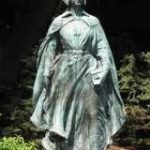The Year: 1623
Bridget Fuller arrived at Plymouth Colony on the Anne in 1623. She was Dr. Samuel Fuller’s third wife, and they had two children together. Details of Bridget’s life aren’t readily available, but we can gain some insight into her life by following her husband’s history.
Samuel Fuller was one of the original members of the Separatist church who fled England for Holland in 1609. He became a physician, making him an important member of the congregation. He later became a deacon of the church at Plymouth Colony.
He sailed on the Mayflower in 1620. Upon arrival in the New World, Dr. Fuller signed the Mayflower Compact, along with the other adult males. He did what he could to alleviate the suffering of the colonists stricken with scurvy and disease, but nearly half of them died that first winter of 1620-1621.
The medical doctrine of the 17th century called for bloodletting to treat diseases. Bloodletting involved the withdrawal of often considerable quantities of blood from a patient, in the hope that this would cure a great many illnesses and diseases. I found no evidence that this happened at Plymouth Colony, but it’s entirely possible that it did.
The Widow Fuller
Dr. Fuller spent time helping the sick at what is now Salem in 1629. He became sick and died during the epidemic of infectious fever in the autumn of 1633, as did a number of other Plymouth residents.
William Bradford wrote about his death:
…and in the end, after he had much helped others, Samuel Fuller who was their surgeon and physician and had been a great help and comfort unto them. As in his faculty, so otherwise being a deacon of the church, a man godly and forward to do good, being much missed after his death. And he and the rest of their brethren much lamented by them and caused much sadness and mourning amongst them, which caused them to humble themselves and seek the Lord; and towards winter it pleased the Lord the sickness ceased.
Evidently, Bridget was very ill when her husband was dying, for in his will he arranged for the education of his children—his daughter, Mercy, as well as his son, Samuel—by his brother-in-law, William Wright, unless it “shall please God to recover my wife out of her weak estate of sickness.”
He also provided for the education of several other children who had been placed in his care upon the death of their parents. Also in his will, he forgave the indigent of doctor’s fees yet owed, bought gloves for many of the colonists, and bequeathed the very cloak off his back to a needy soul.
This kind doctor left a considerable estate. To his wife, he left two houses, “one at Smelt River and another in town.” One gift formed the nucleus of a fund which is still known as the Fuller Ministerial Fund of the Plymouth Congregational Church. Its source was “the first cow calf that his Brown Cow should have.”
Like Elizabeth Warren, Bridget survived her husband for many years and did not remarry. And, like Elizabeth, her name appears in the Plymouth Colony Records many times, as she acquired or traded land and livestock.
Mistress Bridget Fuller lived until after 1667, and exerted a strong influence on the educational life of Plymouth Colony.
RELATED POSTS:
Plymouth Colony Women’s Rights
SOURCES
Wikipedia: Samuel Fuller (Mayflower physician)




Is there any proof of Bridget Fuller being a nurse or midwife? I am trying to ascertain this for the National Society of Colonial Dames. Thank you.
Deborah Britten